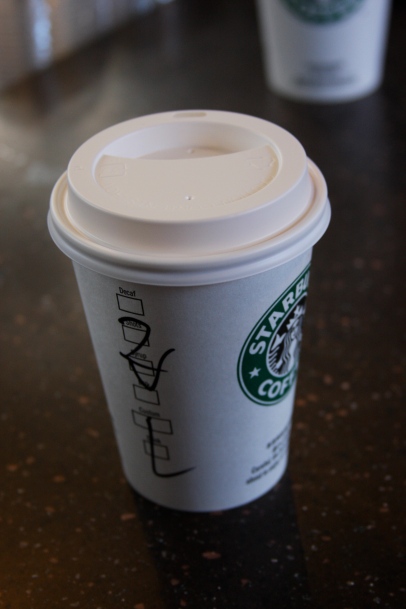
Before I left for Asia, I thought finding my Starbuck’s double, tall, vanilla latte would become a difficult task; on the contrary it has now become an everyday ritual. Even with the language differences, the Baristas know the Starbucks lingo and, after I ramble off my order, they smile back and say, “Will that be all”. Some of the food items are unique to the Starbuck’s region, but all in all it’s just like any other Starbucks back at home. This comfortable atmosphere and exchange simplifies the ordering process, which creates a enjoyable experience.
I started to analyze this relationship I had with the coffee house. Why is it that I continually choose something that is completely western, while I am in Asia for the experience? The surface answer is that it’s easy; I know when I walk into a Starbucks that I will walk out with something that I am satisfied with. I understand what I am ordering, and I am able to convey what I am looking for to the other party.
I brought up this idea in a critique, which talked about the ideas of globalization and branding. The idea that I could have nearly identical exchanges in both the United States and Hong Kong started to sicken me. How could Hong Kong, a city with so much character and uniqueness, have a Starbucks on every corner? I felt that Hong Kong was loosing touch with its identity, and caving into the corporate America model. Starbucks is Starbucks is Starbucks
But is it? A great analogy was brought up during my critique about the idea of appearance, and the distance in which the object is viewed from. For example from far away a surface may look smooth, but as you start to move closer, and actually have the ability to touch the surface, you can realize that the surface is actually a rough texture. This notion of how far you zoom in and analyze the material really provides a greater depth to the problem. The same can hold true for Starbucks. When I first analyzed the situation I took it for its surface value. Walking into the coffee house, I identified with its logos, colors, smells, and tall, grande, viente way of life. At the surface it was Starbucks. On the other hand though this is the phenomenon. Half way across the world Starbucks has the ability to create identical experiences. When I started to look at this as a positive trait, as opposed to a negative, I realized that this is truly spectacular. I am ordering my double, tall, vanilla latte in Hong Kong. In every way this is a Hong Kong coffee house, a place where its residents and tourists come to relax, socialize, and brew up ideas. Two completely different cultures can truly experience and appreciate the same/ but different Starbucks coffee house.
Starbucks is Starbucks is Starbucks mentality is not the end of culture, rather it is a bringing together of cultures. It creates a common tie between America and Hong Kong in which, two completely different cultures could actually sit and talk over the same cup of coffee. As mentioned before this is truly a phenomenon that comes down to Starbuck’s ability to not only make coffee, but to create an atmosphere that appeals to very different people. After stepping back, and zooming into the situation I realized that the concept of globalization might start to blur boundaries among different countries and cities, but at the same time create truly unique connections. Although Starbucks is a corporate America brand, many people in the east have accepted the Starbucks brand as their own. Urban cities are not necessarily about one culture; rather they are about many different cultures coming together. The urban environment plays as the backdrop to many different programs, and it is through different filters that we can start to realize how these different programs play out. You could have two identical programs with two different backdrops, and these backdrops could completely change a person’s experience and interaction with the program. It is this unpredictable factor that makes urbanism a complex riddle that may not have an answer, but when the ingredients mix together just right, you get that perfect double, tall, vanilla latte.
Ross Renjilian
Filed under: America, Branding, Double, Globalization, Hong, kong, L, Latte, Renjilian, Ross, Starbucks, Tall, Urbanism, V, Vanilla, 2, Urbanism


